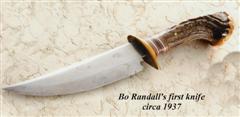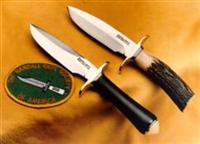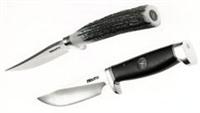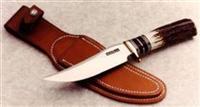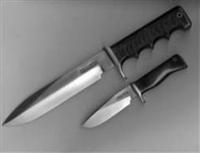These are some miscellaneous notes that I’ve put together on the Model #10 series of knives – I haven’t done any additional research recently, so if you guys can help fill in the blanks here, or help narrow down some of the timeframes, I’d sure appreciate it: Introduced in 1948 as one of the first ‘Stock Removal’ knives made by Bo Randall, this slab-sided model is probably the only Randall knife model configured using this handle style, other than a few ‘special order’ knives made over the years, and the ‘Drop Point Hunter’ series of the late 1970’s & early 1980’s.
Traditionally made from stainless steel, no specific stainless ‘S’ indication was used on Randall Model #10’s prior to the mid 1970’s. Use of the ‘Integral S’ blade stamp on Model #10’s began sometime after 1974, but before 1979. Use of the angled blade stamp orientation on Model #10 knives began sometime in 1979. Originally made from 440B type stainless steel using the stock removal process, by early 1996, ATS-34 stainless steel was in regular production use for this RMK model.
Two handle pins and a lanyard hole on the 5” and 7” models indicates 440B steel; three handle pins and a lanyard hole on those models indicates ATS-34. The 3” model uses one pin for 440B steel knives, two pins for the ATS-34 versions. Collectors should bear in mind, however, that prior to the lanyard hole introduction in early 1988, three pins were standard for larger Model #10 knives, indicating 440B type steel; and, while ATS-34 is now in regular use on many of the smaller RMK stock removal models, its use is only specifically indicated as such on the Model #10 knives.
Micarta was an option on this model as early as 1964, although didn’t get much attention until later in the decade. Micarta became the standard handle material offered in the late 1980’s; at about the same time lanyard holes were introduced. Rosewood handle material had become a cataloged option for this model by 1974, as had Maroon Micarta. Today, if requested, both Rosewood and Aluminum handle scales are still available at no additional cost. (DW, is this still true?)
Standard configurations have traditionally used 5” and 7” blades, but a limited run of 4” models was also made during the late 1980’s. The earliest 4” blades used a traditional blade grind, with a drop point version soon following. The 3” version of this knife become available in 1984 with standard Model #10 type handles and Johnson ‘B’ model sheath; taking on its current contoured black Micarta handle shape in 1989. Variants with the then optional drop-point blade grind and pouch style sheath type were being delivered by 1991; this new blade grind and sheath type would soon become the standard for the model.
Handle materials have ranged from the standard catalog offerings to unusual shop supplied materials such as stag in the mid 1970’s and late 1980’s, and customer supplied materials such as the poly pearl and exotic wood handles that Randall dealer Jack Crider was noted for. Handle shapes have evolved over the years as well, the earliest aluminum handles had thumb notches. The Model #10 has also been used extensively as an experimentation platform; swedged false-edges, double-edged, and sawtoothed configurations have all been seen, along with the use of hilts on a limited number of knives.
With regards to the age of any specific knife, in addition to the various blade grinds, steel type, and handle configurations - the sheath type, provided that it’s original to the knife, can also help approximate the date of manufacture. In the meantime, keep posting photos of your Model #10’s, and...if you don’t already have a hard copy of Rhett’s 1991 Randall ‘Green Catalog’, or a copy of the Intersquare Randall Information CD where it is also shown, I’d recommend that you get one, as it’s chock full of interesting and odd-ball Model #10 variants...
_________________________
If all else fails, punt...


